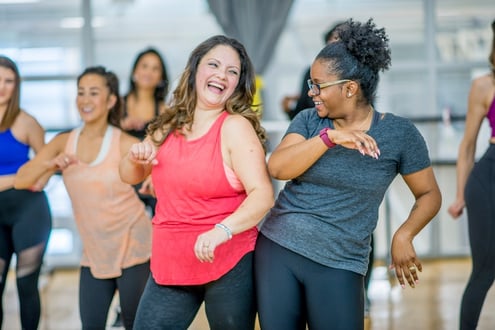 You either love them or you hate them… group workouts! In a world where technology is seemingly taking over the human connection and interaction, working out with a group can offer the opportunity to meet real friends instead of virtual ones online.
You either love them or you hate them… group workouts! In a world where technology is seemingly taking over the human connection and interaction, working out with a group can offer the opportunity to meet real friends instead of virtual ones online.
Whether you join a small group or just get a group of your friends to work out together, here are a few reasons why more is merrier for working toward your fitness goals.
Motivation
Group workouts give you motivation that you might not get by doing a solo workout. Unless you’re that rare person who can jump out of bed at the sound of an alarm and hit the ground running, odds are motivation will go away as quick as you pressing the snooze button. We all battle the everyday ups and downs of life, but once you get together with your group, the energy levels go up and worries go out the door. You will find that you are motivated by the people around you and that’ll make the workout much more fun and enjoyable.
Accountability
Remember when you were a high schooler and your parents would wake you up in the mornings? How nice of them to hold us accountable. A workout group can do the same thing for your health and fitness goals. There’s something about knowing you won’t be the only one getting your butt kicked that day. Not only will you have your group members to help hold you accountable, you will have a coach who is checking in on you. The effectiveness of a team member can influence the whole team. Therefore, don’t let your coach and classmates down by not showing up.
Support System
One day a month, all the members of the Ramp Up to Weight Loss program come together for a group workout followed by a post-workout snack. Not only do they get a chance to meet one another, work out, breathe hard, and sweat; but they also get a chance to see that they aren’t in this alone. They see that they have the support of all the other members who might be in a situation similar to theirs. Having a support system can give you a new sense of hope and encouragement because you know you aren’t in this alone.
Fun
Some people like working out by themselves while others need a group around them. Being part of a group workout can really make exercising fun and enjoyable. You’ll benefit from the energy and hard work you can feel being created by you and the people in your group. The motivation you receive and the people you surround yourself with will make exercise fun, not a chore you feel you have to do.
Mental Health
Group workouts offer you the advantage of getting to meet people who have similar interests to yours. You will feel part of something by being surrounded by likeminded people. You might be afraid to step out of your comfort zone and make new friends; group workouts give you that opportunity to stay within your comfort zone while making new friends.
Although group workouts might not be for everybody, you should try it at least once. You might find that a group atmosphere is exactly what you need to push you past your health and fitness goals. There are so many ways here at NIFS to get involved with a community of supporters: Small Group Training, Group Fitness classes, the Ramp Up to Weight Loss Program, and many of the other programs we provide throughout the year.
“When we try to exercise alone, we can feel isolated and uninspired; together we can achieve our fitness goals.”
This blog was written by Ashley Duncan, Weight Loss Coordinator. To find out more about the NIFS bloggers, click here.


 “You've got this!” "Keep it up!” “So strong!”
“You've got this!” "Keep it up!” “So strong!”  Can you really win by cheating? Well, the obvious answer is no. Morally, we know that cheaters aren’t supposed to win. If that is the case, why do we cheat ourselves through self-destructive behavior, known as cheat days, throughout the week?
Can you really win by cheating? Well, the obvious answer is no. Morally, we know that cheaters aren’t supposed to win. If that is the case, why do we cheat ourselves through self-destructive behavior, known as cheat days, throughout the week?
 When it comes to working out, the first weeks are usually great. You are excited to get to the gym, and you love the feeling of exercising. Once the “honeymoon” stage of your new workout routine is over, it gets more challenging to get to the gym:
When it comes to working out, the first weeks are usually great. You are excited to get to the gym, and you love the feeling of exercising. Once the “honeymoon” stage of your new workout routine is over, it gets more challenging to get to the gym:  For many adults, memories of physical education class are usually one of two greatly different experiences. For me, physical education was the highlight of my day and was never a burden or stressor in my life. For others,
For many adults, memories of physical education class are usually one of two greatly different experiences. For me, physical education was the highlight of my day and was never a burden or stressor in my life. For others,  It’s that time of year when millions of people around the world start looking for that next “best” thing to give them the body they have always dreamed of. Aggressive physical challenges, cleanses, elaborate diets that usually involve the removal of a food source (and result in you craving it even more); people will take some drastic steps to help erase the past year of poor nutrition and lifestyle decisions.
It’s that time of year when millions of people around the world start looking for that next “best” thing to give them the body they have always dreamed of. Aggressive physical challenges, cleanses, elaborate diets that usually involve the removal of a food source (and result in you craving it even more); people will take some drastic steps to help erase the past year of poor nutrition and lifestyle decisions. Not Too Easy to Quit
Not Too Easy to Quit

 Maybe you have found your favorite app to log your workouts, whatever that may be; using a phone makes it so much easier than logging it into a notebook. If you haven’t taken time, download the NIFS app and enjoy many benefits aside from the ones that are listed above. Some of those include: using your phone to scan in at the desk, monthly challenges with great prizes, setting goals, logging workouts, utilizing deals and finding out extra things that may be going on at NIFS, and receive push notifications for important updates!
Maybe you have found your favorite app to log your workouts, whatever that may be; using a phone makes it so much easier than logging it into a notebook. If you haven’t taken time, download the NIFS app and enjoy many benefits aside from the ones that are listed above. Some of those include: using your phone to scan in at the desk, monthly challenges with great prizes, setting goals, logging workouts, utilizing deals and finding out extra things that may be going on at NIFS, and receive push notifications for important updates!
 “Our mindset” refers to every individual who has ever had one slice of pizza too many and subsequently tortured themselves on the treadmill because of it. Exercise is not punishment and should not be viewed as such. If you consistently and begrudgingly plan your workout routine around your indulgences, fitness becomes an irrational afterthought. A healthy lifestyle includes both enjoying the sweeter (or more savory) things in life, as well as enjoying a sweat session for the benefits of fitness. Your body is built to be listened to, and practicing a balanced lifestyle will help you reap not only better health, but also performance benefits.
“Our mindset” refers to every individual who has ever had one slice of pizza too many and subsequently tortured themselves on the treadmill because of it. Exercise is not punishment and should not be viewed as such. If you consistently and begrudgingly plan your workout routine around your indulgences, fitness becomes an irrational afterthought. A healthy lifestyle includes both enjoying the sweeter (or more savory) things in life, as well as enjoying a sweat session for the benefits of fitness. Your body is built to be listened to, and practicing a balanced lifestyle will help you reap not only better health, but also performance benefits. Welcome back to school! Or, if you are new to the college experience, welcome to your first adventure in time management and balancing your life. This not only includes your academics and social life, but other areas that go under the radar as less important. I’m talking about fitness and wellness. College and university fitness centers are usually well populated with individuals with a wide variety of goals ranging from stress reduction to spring break abs, to meeting people.
Welcome back to school! Or, if you are new to the college experience, welcome to your first adventure in time management and balancing your life. This not only includes your academics and social life, but other areas that go under the radar as less important. I’m talking about fitness and wellness. College and university fitness centers are usually well populated with individuals with a wide variety of goals ranging from stress reduction to spring break abs, to meeting people.